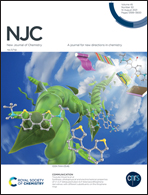Synthesis of a stable iron(iii)–organic framework for a visible light induced simultaneous photocatalytic reduction of Cr(vi) and the degradation of organic dyes in water†
Abstract
In this work, a highly stable Fe-MOF, namely [Fe2(OH)2(BPTC)]·2DMF·2H2O (JOU-22, H4BPTC = biphenyl-3,3′,4,4′-tetracarboxylic acid, DMF = N,N-dimethylformamide), was solvothermally synthesized using lanthanum nitrate and HF as modulators. Single-crystal diffraction shows that JOU-22 reveals a 3D microporous framework based on Fe–O chains. Due to its high chemical stability, suitable band gap (2.1 eV), and appropriate HOMO (−0.21 V) and LUMO (1.89 V) energy, JOU-22 shows efficient visible-light induced photocatalytic activity for Cr(VI) reduction and dye degradation. JOU-22 can also be used for the degradation of organic dyes, including MB, MO, BG and RhB. Fascinatingly, in the mixed system with the co-existence of dichromate anions and MB, the degradation rate of both Cr(VI) and MB increased significantly due to the synergistic effect between the photocatalytic reduction and oxidation process. This work not only provides a new clue for the preparation of large-size Fe-MOF single crystals, but also enriches the application of Fe-MOFs in the treatment of water pollution.



 Please wait while we load your content...
Please wait while we load your content...